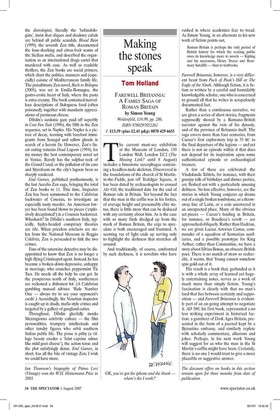Making the stones speak
Tom Holland FAREWELL BRITANNIA: A FAMILY SAGA OF ROMAN BRITAIN by Simon Young Weidenfeld, £16.99, pp. 286, ISBN 9780297852261 £13.59 (plus £2.45 p&p) 0870 429 6655 The current must-see exhibition at the Museum of London, 150 London Wall, London EC2 (The Missing Link? until 8 August) includes a limestone sarcophagus containing a headless male skeleton. Discovered in the foundations of the church of St Martinin-the-Fields, just off Trafalgar Square, it has been dated by archaeologists to around AD 410, the traditional date for the end of Roman rule in Britain. Yet beyond the fact that the man in the coffin was in his forties, of average height and presumably elite status, there is little more that can be deduced with any certainty about him As is the case with so many finds dredged up from the murk of Roman Britain, the urge to speculate is both encouraged and frustated. A seeming ray of light ends up serving only to highlight the darkness that stretches all around.
And traditionally, of course, confronted by such darkness, it is novelists who have rushed in where academics fear to tread. As Simon Young, in an afternote to his new work of fiction points out, Roman Britain is perhaps the only period of British history for which the reading public owes its knowledge more to novels — Kipling and his successors, Henry Treece and Rosemary Sutcliffe — than to textbooks.
Farewell Britannia, however, is a very different beast from Puck of Pook's Hill or The Eagle of the Ninth. Although fiction, it is fiction as written by a careful and formidably knowledgable scholar, one who is concerned to ground all that he writes in scrupulously documented fact.
Rather than a continuous narrative, we are given a series of short stories, fragments supposedly shored by a Romano-British narrator against the ruin of his dynasty, and of the province of Britannia itself. The saga covers more than four centuries, from Caesar's first exploratory trip in 55 BC to the final departure of the legions — and yet there is not an episode within it that does not depend for its inspiration upon some authenticated episode or archaeological treasure.
A few of these are celebrated: the Vindolanda Tablets, for instance, with their gossipy talk of birthdays and dinner parties, are fleshed out with a particularly amusing deftness. No less effective, however, are the stories in which Young conjures up drama out of a single broken tombstone, or a throwaway line of Latin, or a coin uncovered in an unexpected place. Many of the obvious set-pieces — Caesar's landing in Britain, for instance, or Boudicca's revolt — are approached obliquely. Rather than Hadrian, we are given Lucius Artorius Castus, commander of a squadron of Sarmatian auxiliaries, and a possible prototype for King Arthur; rather than Constantine, we have a story about Silvius Bonus, an obscure British poet. There is no snatch of straw so recherché, it seems, that Young cannot somehow spin gold out of it.
The result is a book that, garlanded as it is with a whole array of learned yet hugely entertaining notes, serves as a work of much more than simply fiction. Young's fascination is clearly with that no man's land that lies between certainty and supposition — and Farewell Britannia is evidently part of an on-going attempt to negotiate it. AD 500, his first book, represented a no less striking experiment in historical faction: a gazetteer of Dark Ages Britain, presented in the form of a journal kept by a Byzantine embassy, and similarly replete with scholarly commentary, allusions and jokes. Perhaps, in his next work Young will suggest for us who the man in the St Martin's coffin might have been. Certainly, there is no one I would trust to give a more plausible or suggestive answer.
The discount offers on books in this section remain open for three months from date of publication.








































 Previous page
Previous page